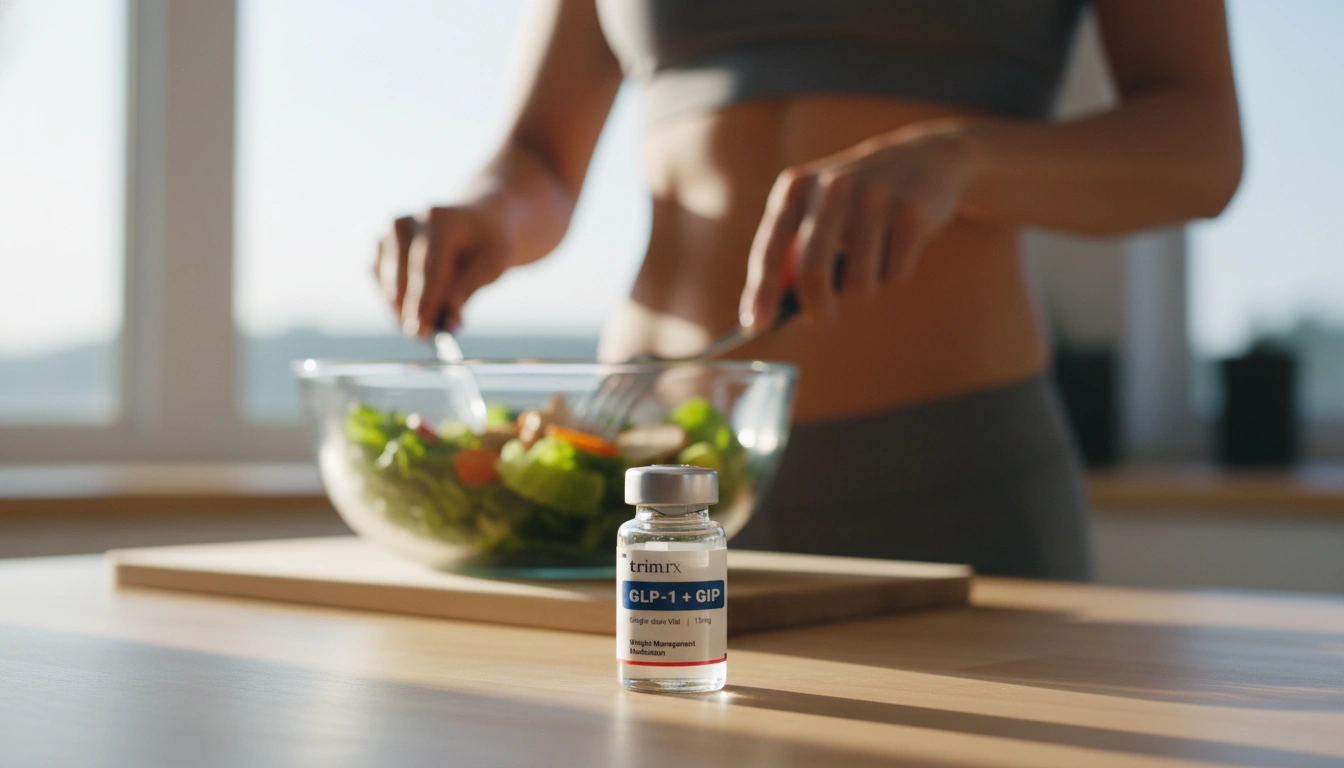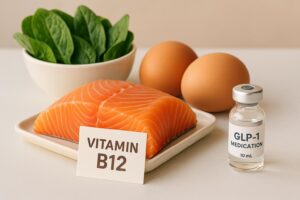Can You Increase GLP-1 Naturally? Exploring Dietary and Lifestyle Approaches

Introduction
In the quest for effective weight management and better metabolic health, many individuals are on the lookout for solutions that not only work but are also sustainable over the long term. One of the buzzworthy hormones gaining attention in recent years is glucagon-like peptide-1 (GLP-1). This powerful hormone, naturally produced in our bodies, plays a crucial role in regulating appetite and blood sugar levels. However, as we navigate our health journeys, the question arises: Can you increase GLP-1 naturally?
Understanding GLP-1 is essential, especially as it has become a focal point in discussions about weight loss and diabetes management. With the rise of GLP-1 receptor agonists, such as semaglutide and tirzepatide, many are curious about whether dietary and lifestyle changes can enhance GLP-1 levels without medication.
In this blog post, we will delve into the science behind GLP-1, explore natural ways to boost its production, and highlight the role of a healthy gut microbiome. Our goal is to provide you with actionable insights on how to support your body’s natural mechanisms for improved health.
What You Will Learn
- The role and function of GLP-1 in the body
- Natural dietary sources that can enhance GLP-1 levels
- Lifestyle changes to support GLP-1 production
- The importance of gut health in hormone regulation
- Practical tips for incorporating these strategies into your daily routine
As we embark on this exploration together, let’s uncover how we can empower our bodies to optimize GLP-1 levels through natural means.
Understanding GLP-1: The Basics
GLP-1 is an incretin hormone produced in the intestines in response to food intake. It serves several vital functions, including:
- Stimulating Insulin Secretion: GLP-1 enhances the secretion of insulin from the pancreas when blood sugar levels rise, helping to lower blood sugar levels effectively.
- Inhibiting Glucagon Release: This hormone reduces the release of glucagon, which is responsible for raising blood sugar levels, thereby contributing to better glucose control.
- Slowing Gastric Emptying: GLP-1 slows down the rate at which food leaves the stomach, promoting a feeling of fullness and reducing appetite.
- Enhancing Satiety: By sending signals to the brain, GLP-1 helps regulate hunger and satiety, making it easier to manage food intake.
The significance of GLP-1 in weight management cannot be overstated. As we consider how to increase GLP-1 naturally, it’s essential to remember that dietary choices and lifestyle habits play a crucial role in its production.
Dietary Approaches to Boost GLP-1
1. Emphasize Fiber-Rich Foods
One of the most effective ways to enhance GLP-1 levels is through a diet rich in fiber. When we consume fiber, especially soluble fiber, it is fermented by gut bacteria, producing short-chain fatty acids (SCFAs) that stimulate GLP-1 secretion. Here are some fiber-rich foods to consider:
- Whole Grains: Foods like oats, barley, and whole wheat are excellent sources of soluble fiber, which can help increase GLP-1 levels.
- Fruits and Vegetables: Apples, pears, carrots, and broccoli are high in fiber and beneficial for gut health.
- Legumes: Beans, lentils, and peas not only provide fiber but also protein, which can further enhance GLP-1 secretion.
2. Include Healthy Fats
Healthy fats, particularly monounsaturated fats, have been shown to promote GLP-1 release. Incorporating the following foods into your diet can be beneficial:
- Avocados: Rich in fiber and healthy fats, avocados can help regulate blood sugar levels and increase satiety.
- Olive Oil: Using olive oil in cooking or as a dressing can provide healthy fats that support GLP-1 secretion.
3. Protein Power
Protein is another essential macronutrient that can stimulate GLP-1 production. Incorporating a variety of protein sources can enhance your meals:
- Eggs: This versatile food is rich in protein and has been shown to support GLP-1 levels effectively.
- Nuts and Seeds: Almonds, walnuts, and chia seeds are great snacks that provide protein, healthy fats, and fiber.
4. Fermentable Fiber Sources
Fermentable fibers are particularly effective at boosting GLP-1 levels due to their interaction with gut bacteria. Some excellent sources include:
- Barley: This grain is rich in beta-glucan, a type of soluble fiber that can lead to increased GLP-1 production.
- Psyllium: Often found in fiber supplements, psyllium can also promote GLP-1 levels when included in the diet.
The Role of Gut Health in GLP-1 Production
A well-balanced gut microbiome is crucial for the optimal production of GLP-1. Our gut is home to trillions of microorganisms that significantly influence our metabolic health. Here’s how you can support your gut health:
1. Probiotics and Prebiotics
-
Probiotics: Consuming foods rich in probiotics, such as yogurt, kefir, and fermented vegetables, can help maintain a healthy gut microbiome. Strains like Bifidobacterium and Lactobacillus have been associated with increased GLP-1 production.
-
Prebiotics: Foods that contain prebiotics, such as garlic, onions, and asparagus, feed the beneficial bacteria in your gut, promoting the production of SCFAs and enhancing GLP-1 levels.
2. Reduce Processed Foods
Minimizing the intake of processed foods can help maintain a diverse gut microbiome. Processed foods often lack beneficial nutrients and can disrupt the balance of gut bacteria, negatively impacting GLP-1 production.
3. Hydration and Fiber
Staying adequately hydrated is essential for digestion and gut health. Pairing hydration with a high-fiber diet can optimize gut function and promote the growth of beneficial bacteria that enhance GLP-1 levels.
Lifestyle Changes to Enhance GLP-1 Production
In addition to dietary changes, certain lifestyle practices can support your body’s ability to produce GLP-1 naturally.
1. Regular Physical Activity
Engaging in regular exercise has been shown to improve insulin sensitivity and may help increase GLP-1 levels. Aim for:
- 150 Minutes of Moderate Exercise: Activities such as brisk walking, cycling, or swimming can be beneficial.
- Strength Training: Incorporating resistance exercises at least two days a week can further enhance metabolic health.
2. Manage Stress
Chronic stress can negatively impact hormone levels, including GLP-1. Implementing stress-reduction techniques such as meditation, yoga, or deep-breathing exercises can help maintain hormonal balance.
3. Prioritize Sleep
Quality sleep is vital for overall health and hormonal regulation. Aim for 7-9 hours of restorative sleep each night to support your body’s natural hormone production, including GLP-1.
Conclusion
In our journey to understand how to increase GLP-1 naturally, we’ve uncovered the significant impact of diet, lifestyle, and gut health on this powerful hormone. By embracing a fiber-rich diet, incorporating healthy fats and proteins, and supporting our gut microbiome, we can enhance our body’s natural GLP-1 production.
As we continue to explore the connections between our food choices and hormonal health, it’s crucial to remember that these changes don’t have to be overwhelming. Small, sustainable adjustments in our diet and lifestyle can lead to significant improvements in our overall well-being.
At TrimRx, we believe in the power of personalized, medically supervised weight loss solutions that incorporate science and empathy. If you’re interested in exploring tailored weight loss programs, consider taking our free assessment quiz to see if you qualify for prescription weight loss medications designed to help you achieve your goals.
Additionally, if you’re looking for immediate support supplements, our GLP-1 Daily Support and Weight Loss Boost can complement your weight loss journey.
FAQ
What foods can naturally increase GLP-1 levels?
Foods high in fiber, such as whole grains, fruits, vegetables, legumes, and healthy fats like avocados and olive oil, can help boost GLP-1 production.
How does exercise influence GLP-1?
Regular physical activity can improve insulin sensitivity and may lead to increased GLP-1 levels. Aim for a mix of aerobic and strength-training exercises for optimal benefits.
Can I increase GLP-1 through supplements?
While some supplements may claim to boost GLP-1, it’s essential to focus on a balanced diet rich in fiber and probiotics for the most effective results. Always consult with a healthcare provider before starting any new supplement.
How important is gut health for GLP-1 production?
Gut health is crucial for GLP-1 production, as a balanced gut microbiome supports the fermentation of fiber into SCFAs, which stimulate GLP-1 secretion.
What role does stress play in GLP-1 levels?
Chronic stress can negatively affect hormonal balance, including GLP-1 levels. Incorporating stress management techniques can help maintain healthy hormone levels.
By taking these insights to heart and implementing the strategies discussed, we can all work towards enhancing our GLP-1 levels naturally and support our overall health journey. Together, let’s embrace the path to a healthier lifestyle!

Transforming Lives, One Step at a Time
Keep reading
Vitamin B12 and GLP-1 Medications: What to Know
GLP-1 medications can lower B12 absorption and intake; learn symptoms, food sources, supplement options, and how to monitor levels.
Semaglutide Injection Site Reactions: What To Know
Learn why semaglutide injections can cause redness, swelling or nodules, how to prevent and treat them, and when to seek medical care.
TrimRx vs Friday’s
Compare TrimRx and Friday’s telehealth GLP-1 weight-loss programs: pricing, medical support, coaching, delivery, and which fits your needs.



